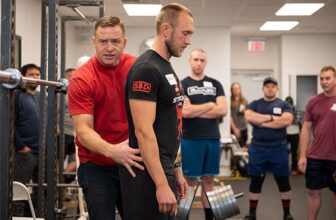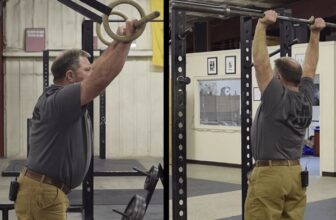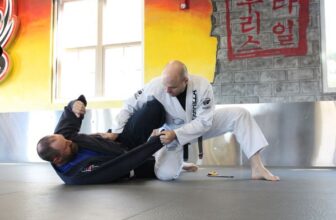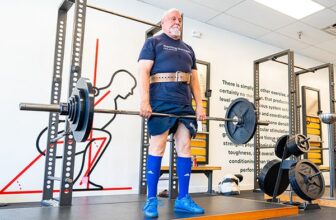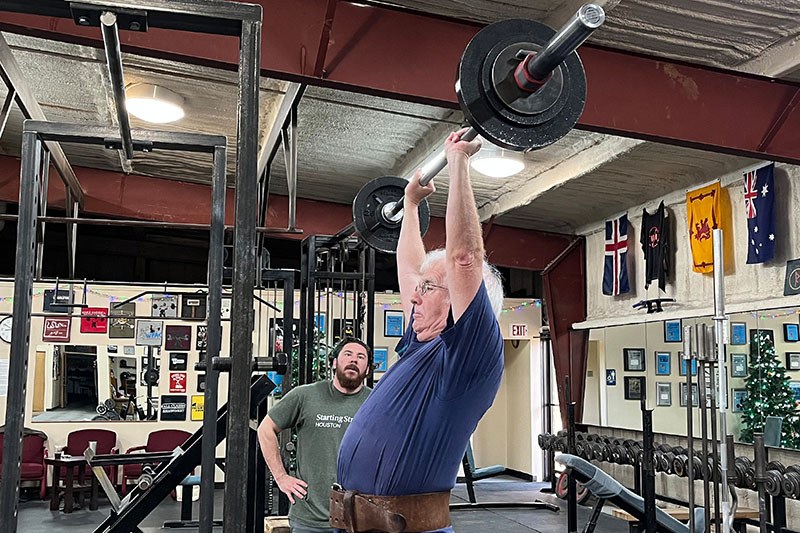
[adinserter block=”2″]
Six Short Stories About Training at WFAC
by Phil Ringman | April 04, 2023
I was having lunch recently with three
friends, all of us now in our mid 60s to early 70s. One of my friends
has taken up pickleball, the current “in” sport for aging weekend
athletes. While we were eating, one of my friend’s occasional
pickleball partners came by the table to say hello. The pickleball
partner, also in his 70s, was a top-ranked tennis player in high
school and in the military. The conversation turned to the previous
athletic exploits of the rest of us, and our new friend, who did not
know me from Adam, turned and said, “You look like you were a
football player.”
I nearly fell out of my chair. I’ve
never played organized football, let alone been mistaken for a
football player. In fact I was pretty much the opposite of a football
player – I was a distance runner for 51 years until sidelined by
bone spurs in my big toe.
I began strength training at Wichita
Falls Athletic Club nine years ago, at age 59. That can be the only
possible reason why he thought I was a football player. Obviously, I
am stronger after lifting for several years. But I never thought that
I would actually look bigger and stronger, particularly since my
bodyweight is essentially unchanged, staying pretty much between 215
and 220 pounds since well before I began lifting.
A
Famous Gym
When I first started training at WFAC,
I didn’t fully appreciate that it is one of the most well-known gyms
in the country. Pretty much all I knew at the time was that Mark
Rippetoe, the owner, was a prominent guy in the strength training
field, and had written some best-selling books.
A long-time runner, I had only been
training at WFAC a few months, lifting one day a week while still
running three days a week. It was a Sunday afternoon and I had the
gym to myself when I heard a knock at the front door. The doors are
locked after hours and on weekends, and we’re not supposed to let in
non-members, but it was a 30-something couple who looked harmless so
I opened the door to see what they wanted. They said they had “always
wanted” to see the WFAC and could they come in and look around?
They said they were driving
cross-country on I-40, which at its closest point to Wichita Falls is
at least two hours or so to the north in Oklahoma, and saw that going
through Wichita Falls was “not that far out of the way.” They
looked around for a few minutes, took some photos on their cell
phones, and left. Apparently visiting WFAC is a bucket list item for
some people.
That was my first clue that there was
something special about WFAC. I have since met lifters from China and
Portugal who have taken the time and spent a significant amount of
money to travel to Wichita Falls for in-person instruction from Rip
and other SSCs at the weekend seminars. And I’ve met coaches from
England and Belgium. Wichita Falls is not an easy place to get to.
Not counting international flights it still involves at least one and
possibly two plane changes, or flying and then renting a car and
driving 120 miles from either the Dallas or Oklahoma City airports.
I’m spoiled. It takes me under 10
minutes to get to WFAC.
Why
People Need Coaching
Not too many months after meeting the
cross-country travelers, I was training on a Thursday afternoon and
one of the Starting Strength Coaches, who came from out of town to
help at the seminar that weekend, had come in early and was visiting
with Rip in his office, which is just off the main training area.
Even though I didn’t hear anything else in their conversation, at one
point I distinctly heard Rip telling the other coach, “That’s why
people need coaching.”
I can’t prove it, but I was doing
squats at the time and I am certain the comment was directed at me.
My crime was poor form and insufficient depth. I should have taken
the comment to heart and gotten a coach. But since I was squatting
only once a week, and at that time I still viewed lifting as a
supplement to my running, I ignored it. I knew I wasn’t squatting
correctly much of the time, and I wanted to do it correctly, but I
figured I could get it eventually on my own. Not necessarily.
Trusting
Your Coach
Fast forward several years. Now no
longer running, I had gotten decently strong following the Starting
Strength program with help from a friend, the books and videos, and
occasional informal coaching from the WFAC coaches. Squats had
improved but were still far from consistent. I finally realized I
did, in fact, need a coach to help with technique and programming,
and I hired one of the WFAC coaches, Rusty Holcomb, 16 months ago.
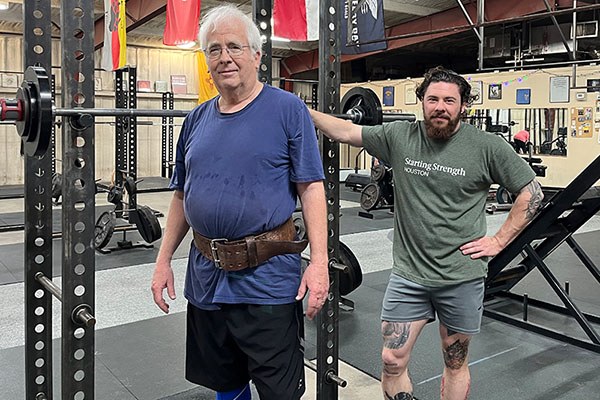
Recently Rusty changed my programming
to a heavy deadlift only once every four weeks (“heavy” obviously
being relative) instead of every week in order to allow more recovery
time for my 68-year-old body. I didn’t think a heavy day once a month
was enough. It’s not that I doubted Rusty, but it was new territory
for me and I wasn’t sure what that would be like. “Don’t worry
about it, you’ll be fine,” he said, more than once.
The day came. I added five pounds to my
deadlift from four weeks earlier and (fairly) easily did a set of
three, and then easily did two backoff sets of three each at 90
percent of the top weight. And on the next cycle a month later I
added five more pounds. Sure enough, I was “fine.”
Here is the heavy day schedule, on
Fridays, alternating squats and pulls every other week:
- Week 1 – squat ( 1×3 heavy set, 2×3
backoff sets) - Week 2 – rack pull (2×3 heavy sets)
- Week 3 – squat (1×3 heavy set, 2×3
backoff sets) - Week 4 – deadlift (1×3 heavy set, 2×3
backoff sets)
Monday is volume day, including a 1×5
“light” deadlift at 80-85 percent of my most recent heavy
deadlift. Wednesday is light day. Press and bench press are
alternated every other training session, so over a two-week period
there are three sessions of each.
If you can, get a coach. And then do
what he tells you.
An
Old Folks’ Rehab Center
I don’t know the age breakdown of the
people who train regularly at WFAC, but I suspect the average age
skews older. I am not the oldest regular trainee but I am on the
older end of the spectrum. When I trained in the afternoons I noticed
that I was often the actual oldest person there. Now, since hiring
Rusty, I have moved to M-W-F mornings and train at the same time as
Nick, a retired firefighter, John, a retired special forces guy and
sheriff’s deputy, John’s wife Alys, and me, a retired financial
advisor. With all of us coached by Rusty.
Nick noted one morning that if a
stranger accidentally came in the WFAC door, not knowing where he
was, he would see all the gray hair and think that he was in the
rehab center at an old folks’ home. However, it would become clear
pretty quickly that WFAC is not your typical rehab center because of
the amount of weight being moved by the people with the gray hair.
“Full
Metal Jacket”
I have never trained anywhere else so I
don’t know what it is like at other gyms, but lifters at WFAC are
very supportive and encouraging to each other, even sometimes during
warmup sets. It’s not hard to tell when someone is pushing their
limits, especially when the coach is loudly giving cues. Other
lifters tend to pause and watch, and offer their own encouragement.
Unlike big box gyms where everyone is doing their own thing, and
nobody knows or likely cares what the others are doing, everyone at
WFAC is essentially doing the same program. So the encouragement is
more meaningful because every other lifter has either already been
there, or soon will be.
One morning a younger WFAC regular came
in and told John, who is known for his encouragement to other
lifters, that he was “going to need the “Full Metal Jacket
treatment” that day when he got to his rack pulls. (For those not
familiar, there is a memorable scene in the 1987 movie Full Metal
Jacket where Gunnery Sgt. Hartman, played by the late actor R.
Lee Ermey, meets his new platoon for the first time, using some
extremely colorful language.)
John’s language was not remotely as
colorful as Sgt. Hartman’s, and obviously the lifter still has to do
the hard work, but somehow hearing other people encourage you, and
knowing they’re also watching you, provides the little bit of extra
oomph to successfully complete a heavy set. I find this at WFAC, and
I’m glad I’m here.
Discuss in Forums
[adinserter block=”2″]
Credit : Source Post



